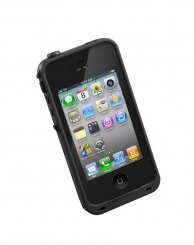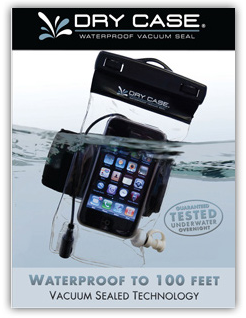
Category: Technology


REVIEW: LifeProof – Waterproof iPhone Case
 This water/dirt/snow/shock-proof case is designed to go on your phone and stay there. For the protection it offers, the slim design makes it practical to leave this case on your phone for full time protection, not just when you want to get out in the elements. As the instructions suggested, I first tested the case empty as the waterproofness is not intuitively apparent. But once that past the test I inserted my phone and haven’t taken it out since. Until something that does everything this LifeProof case does and resolves some of the issues I mention below, this will continue to be how I protect my iPhone.
This water/dirt/snow/shock-proof case is designed to go on your phone and stay there. For the protection it offers, the slim design makes it practical to leave this case on your phone for full time protection, not just when you want to get out in the elements. As the instructions suggested, I first tested the case empty as the waterproofness is not intuitively apparent. But once that past the test I inserted my phone and haven’t taken it out since. Until something that does everything this LifeProof case does and resolves some of the issues I mention below, this will continue to be how I protect my iPhone.
GEAR: DryCase – Waterproof your iPhone
 The vacuum seal tells all. Drop your mobile phone into this clear plastic case, pump (or suck) the air out and you’re good to go. By virtue of the vacuum holding, you know your kit is protected. And with a waterproof headphone jack, you can still get your tunes or make a call. The DryCASE allows for full touch screen functionality and comes with a buoyant armband, lanyard and hand pump.
The vacuum seal tells all. Drop your mobile phone into this clear plastic case, pump (or suck) the air out and you’re good to go. By virtue of the vacuum holding, you know your kit is protected. And with a waterproof headphone jack, you can still get your tunes or make a call. The DryCASE allows for full touch screen functionality and comes with a buoyant armband, lanyard and hand pump.
This is a great solution for occasional waterproof protection when you know you’re going to be in a wet or dirty environment, but not practical for everyday use. It’s easy to get your device in and out of the case and has an arm-band for more active and pocket-less activities. In fact, it probably won’t fit in your pocket if you had one. The DryCASE will also do well just sitting in the sand next to your lounge chair or beach towel and you won’t have to worry about anyone kicking sand or standing above it with a dripping swim suit.
GEAR: Portable Power – Solar Charging on the trail
STS-133: Discovery’s Last Launch
It’s been a childhood dream to see a Space Shuttle launch and only with the threat of the program ending have I put a concerted effort towards actually getting there to see it. Last fall I spent a week on the Space Coast in Florida waiting for STS-133, the Shuttle Discovery to fly it’s last mission. Each day they delayed the launch until finally I couldn’t afford to spend more time in Florida and they scrubbed the launch for at least a few weeks.
After months of going over the leaky fuel tank and related components the launch was scheduled again for 24 Feb 2011 and I was there, again.
As I suspected, after having so much time to get ready for the launch, Discovery was ready to go and lifted off without a hitch, much less any major holds in the countdown sequence.
At the range of about 7 miles on the 5th floor of a condo complex where some friends have a unit I got to see, hear and feel the excitement of witnessing humans breaking away from the grasp of gravity into space. It is awe inspiring.
STS-133 carried a storage module to the International Space Station as well as a new and permeant crew member: Robonaut 2. Click below for more photos.

 Like || Tweet || More Photos || Purchase Photo
Like || Tweet || More Photos || Purchase Photo Like || Tweet || More Photos || Purchase Photo
Like || Tweet || More Photos || Purchase Photo